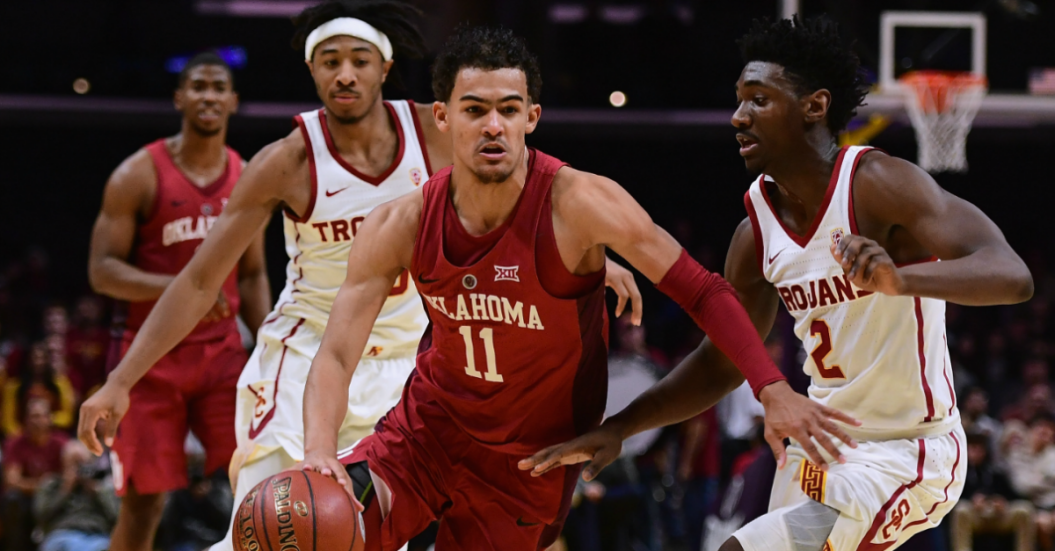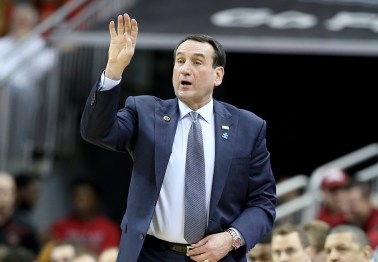College basketball is a funny sport. For the majority of the season, die-hard fans bicker over teams, players and about the warmth of the seat coaches are sitting on. It makes for great content.
Then a funny thing happens. As March begins to loom, casual fans start to trot about the sport's facade. Discussions go from preseason rankings to what players will make for the best professionals. This, too, makes for great content.
Hooray, content — or something. You need not worry about those semantics. Anyway, I digress.
College basketball stock watch is that middle ground. Where (other people's) expectations are balanced with events happening. It isn't whether or not Team- or Player-X is any good. More accurately, it concerns how those entities are performing relative to the burden we've placed on their shoulders via our narratives and hyperbolic statements.
We are, fundamentally, an awful species.
Sell Your Trae Young Stocks
He Is Good
No one is going to say anything negatively about Trae Young the college basketball player. Nor should they. Not only is the Oklahoma Sooners guard putting up Pistol Pete-like stats, but he's doing so in an efficient way.
In terms only relative to college hoops, he's become a legit must-watch talent and the sort that can carry a team with a few holes in it to places it would otherwise not go.
He's like the college hoops version of Shaq, but tiny and with the ability to make shots from the charity stripe.
To get the semantics out of the way: Young is averaging 29.6 points per contest on 48 percent shooting from the floor while connecting on 41 percent of his attempts from beyond the arc. Couple that with his 10.7 assists per game, and we have a clear front-runner for the Naismith Award.
Ugh... Why Are We Selling?
The hyperbolic statements surrounding Young are never going to be as strong as they are now. He's getting compared to Steph Curry, has moved up in nearly every NBA Draft mock this side of free content, and there's no real reason to expect that sort of love to slow down.
Bluntly put: Many — not all, obviously — have already made up their mind in regard to what Young is. Mind you, this has happened after the guard's absolute dominance during non-conference play, but only against a few NCAA Tournament quality teams.
He's yet to navigate through the treacherous Big 12 docket.
https://www.youtube.com/watch?v=UQElqUYfumw
His production has to dip at some point, or at least I think it has to. There's nearly no way he can be as prolific with his volume shooting and remain effective while doing so. Especially not when Big 12 coaches continue to consume film on him, gathering as much data as possible, then planning to focus their defenses on only stopping him.
Will he continue to be great? Of course. He's not going to randomly become an iffy unpaid laborer.
That's the other side of this discussion, though. As mentioned in the opening of this column, the NBA hipsters have begun their annual journey to the realm of free labor performing wonderful acts of athleticism for our entertainment. In turn, people have lost their collective minds with the idea of what he can be when his professional career starts.
Let's make this Camp Crystal Lake clear: Trae Young is one of the best college basketball players I've ever seen. He's the most dominant freshman since Michael Beasley was making opponents look like fools while he was at Kansas State.
Being a prolific college player, however, doesn't inherently mean greatness awaits in the NBA.
Jimmer Fredette, Buddy Hield (though, he's found his niche), Nik Stauskas, etc., have all had varying degrees of professional success. None, though, have been nearly as amazing as they were in the college game.
Why bring up those guys? They are similar in their non-athletic for the NBA, yet absurdly athletic to the college game beings.
Young is athletic, for college basketball. He doesn't seem overly athletic, though. Not the sort that can attack the rim in the NBA with great ease. He is shooting below 53 percent at the rim in college, which is below average for a guard, lends credence to that idea.
For me, I am concerned about his ability to create space in the NBA and how his already-woeful defense will translate. Moreover, his ability to make tough shots in college isn't a transferable ability to the pros — just ask Malachi Richardson.
He won't even have the benefit of being able to shoot over people, like a Richardson or Stauskas.
To be fair to him, there's a chance he can create space by way of running off screens. Unfortunately for his draft prospects, Oklahoma doesn't use him in that capacity, nor should they. Young is OU's primary ball-handler for a reason. The inferior defenders he is facing can't stop him.
Why tinker with something that's not broken?
As much as many of us want it to be something else, a college basketball program's job is not to make a freshman guard NBA-ready. It is to win games. For the Sooners to win as many as possible, Young's collegiate strengths — which might be his professional flaws — need to be highlighted.
Finally, the last reason to sell your Young shares is that his great play has heightened the expectations for the Sooners come March. A team that was once thought to be a middling roster in the Big 12 now has Final Four aspirations.
This part is the easiest to explain and you don't even have to agree with any of the other nitpicking that came before it. Don't correlate individual greatness with team potential team success.
The NCAA Tournament is set in a format that has purposely designed anarchy built in its foundation. It is why upsets are so prevalent and why we believe in numerous Cinderella stories each year. A single-game elimination setting doesn't consistently allow for the best teams to advance each round.
With there being 68 teams allowed in the Big Dance, simple math suggests you should take the field over an Oklahoma team so reliant upon one player for the majority of its offense. As a result of that, this crazily priced Trae Young stock will inevitably dip because people love to build others up, only to come crashing down on them when they fall.
Sell The Assist Stat, Too
Assists In A Nutshell
Assists are meant to be a form of data that helps us evaluate what players are good at creating scoring opportunities for teammates.
The Data Is Now Corrupt
An assist shouldn't be reward for a player not actually creating offensive opportunities, then a teammate simply hitting an open jumper. And yet, those players are rewarded for an assist when that happens.
Assists shouldn't be given to players who pass the ball to another, with the ball-handler attacking the rim while cutting through numerous defenders on his own. And yet, that passer is given the nod.
This isn't any one person's fault, but the baseline numbers for assists are now becoming as valuable as the "steal" stat. How many steals a player averages per game is usually an awful indicator about that person's defensive abilities. If anything, it might actually highlight how the player is a bad player on that end of the floor, taking too many gambles.
I don't know what the fix is to this. Maybe a hockey-like version, where the true creator of offense is given a numerical attribute to show how he helped the offense score. Then again, that still wouldn't fix the foundation of this issue, which is how freely assists are given when they actually shouldn't be.
Assists are dead.


